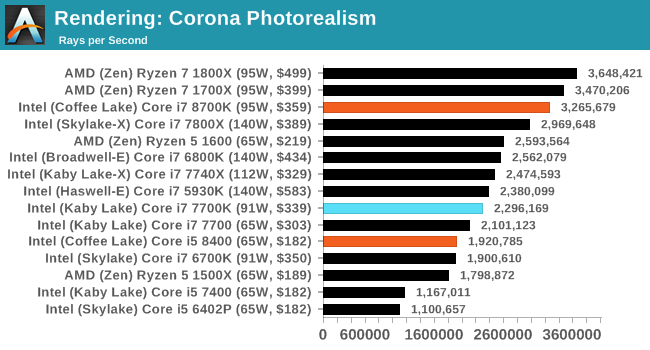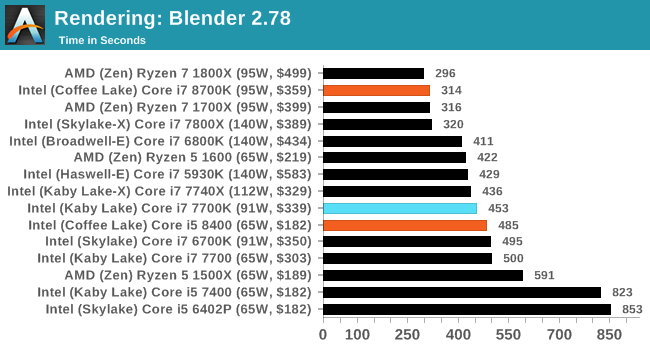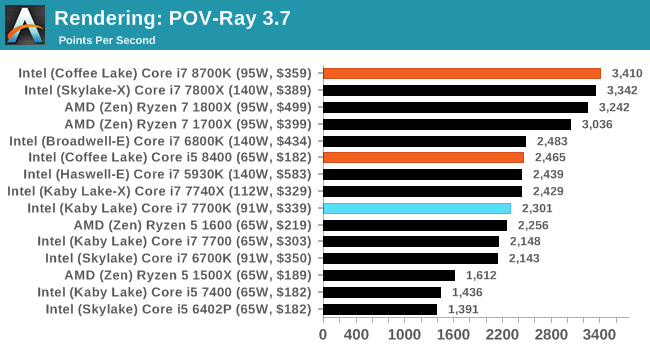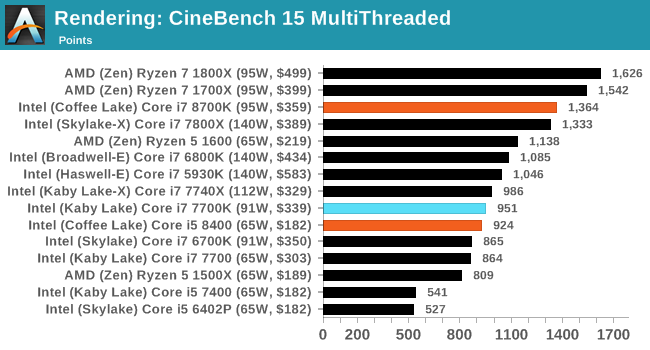The AnandTech Coffee Lake Review: Initial Numbers on the Core i7-8700K and Core i5-8400
by Ian Cutress on October 5, 2017 9:00 AM EST- Posted in
- CPUs
- Intel
- Core i5
- Core i7
- Core i3
- 14nm
- Coffee Lake
- 14++
- Hex-Core
- Hyperthreading
Benchmarking Performance: CPU Rendering Tests
Rendering tests are a long-time favorite of reviewers and benchmarkers, as the code used by rendering packages is usually highly optimized to squeeze every little bit of performance out. Sometimes rendering programs end up being heavily memory dependent as well - when you have that many threads flying about with a ton of data, having low latency memory can be key to everything. Here we take a few of the usual rendering packages under Windows 10, as well as a few new interesting benchmarks.
All of our benchmark results can also be found in our benchmark engine, Bench.
Corona 1.3: link
Corona is a standalone package designed to assist software like 3ds Max and Maya with photorealism via ray tracing. It's simple - shoot rays, get pixels. OK, it's more complicated than that, but the benchmark renders a fixed scene six times and offers results in terms of time and rays per second. The official benchmark tables list user submitted results in terms of time, however I feel rays per second is a better metric (in general, scores where higher is better seem to be easier to explain anyway). Corona likes to pile on the threads, so the results end up being very staggered based on thread count.

With more threads on display, the Core i7-8700K gets ahead of the previous mainstream Core i7 parts. The frequency difference over the Skylake-X processor gives an extra +10% performance, but the 16-thread parts from AMD win out overall.
Blender 2.78: link
For a render that has been around for what seems like ages, Blender is still a highly popular tool. We managed to wrap up a standard workload into the February 5 nightly build of Blender and measure the time it takes to render the first frame of the scene. Being one of the bigger open source tools out there, it means both AMD and Intel work actively to help improve the codebase, for better or for worse on their own/each other's microarchitecture.

Blender seems to separate very nicely into core counts, with six cores from Intel matching eight cores from AMD.
LuxMark v3.1: Link
As a synthetic, LuxMark might come across as somewhat arbitrary as a renderer, given that it's mainly used to test GPUs, but it does offer both an OpenCL and a standard C++ mode. In this instance, aside from seeing the comparison in each coding mode for cores and IPC, we also get to see the difference in performance moving from a C++ based code-stack to an OpenCL one with a CPU as the main host.

POV-Ray 3.7.1b4: link
Another regular benchmark in most suites, POV-Ray is another ray-tracer but has been around for many years. It just so happens that during the run up to AMD's Ryzen launch, the code base started to get active again with developers making changes to the code and pushing out updates. Our version and benchmarking started just before that was happening, but given time we will see where the POV-Ray code ends up and adjust in due course.

Cinebench R15: link
The latest version of CineBench has also become one of those 'used everywhere' benchmarks, particularly as an indicator of single thread performance. High IPC and high frequency gives performance in ST, whereas having good scaling and many cores is where the MT test wins out.


CineBench R15 in single thread mode can take the Core i7-8700K by the horns and drag it to be the best performing chip ever tested.










222 Comments
View All Comments
watzupken - Saturday, October 7, 2017 - link
There are pros and cons of having integrated graphics. It sure takes up a lot of die space, but it is something that allows Intel to sell a lot of chips. Amongst enthusiasts, this is unnecessary, but this group may only represent a small percentage vs corporates that need only decent CPU and no need for fancy graphics. To be honest, Intel could likely have created a 8 core processor easily since the die size is still fairly small for Coffee Lake, but they chose not to. I don't think it is a matter of the graphic that is holding them back.James5mith - Friday, October 6, 2017 - link
Now to wait for the generation of Intel CPU's with native Thunderbolt3 on-die like Intel announced earlier this year.Zingam - Saturday, October 7, 2017 - link
Why is that a good thing?ReeZun - Friday, October 6, 2017 - link
"The difference between the Ryzen 5 1500X and the Core i3-8350K would be interesting, given the extreme thread deficit (12 threads vs 4) between the two."The 1500X houses 8 threads (not 12).
watzupken - Saturday, October 7, 2017 - link
The difference between the R5 1500X and i3 8350K goes beyond just the number of threads. The cache is also 2x more on the Ryzen chip. However, the i3 chip have the advantage of being able to reach higher clockspeed. I do agree that this will be an interesting comparison.sweeper765 - Friday, October 6, 2017 - link
I'm not up to date with current bios versions.Is multi-core enhancement still present in z370 motherboards? That would get rid of all those differences in turbo speeds. I know it is technically overclocking but i bet it's a pretty safe procedure without increasing the voltages.
Also, what's the deal with the 8700? Is it just as good as 8700k (minus 100mhz) if one decides not to overclock? Just trying to gather as many practical facts as i can before formulating an upgrade plan (sandy bridge user hehe )
This cpu family looks good on specs and benches (maybe the first worthy successor to sandy bridge) but it's not perfect. I hate that Intel decided not to solder, i expect temperatures to soar in the high 80's. Also the current motherboards are somewhat lacking in ports (usb, lan, sata).
I love my sandy bridge setup though.
6 1/2 years old and still going strong. Overclocked, cool, stable, silent. With current cpu's you don't get all these points.
Even if i upgrade i'm not going to touch it.
Ian Cutress - Saturday, October 7, 2017 - link
Is multi-core enhancement still present in z370 motherboards?As an option, yes.
As default? Will vary board to board. You can disable it.
However we had trouble with one of our boards: disabling MCT/MCE and then enabling XMP caused the CPU to sit at 4.3 GHz all day. Related to a BIOS bug which the vendor updated in a hurry.
Jodiuh - Friday, October 6, 2017 - link
What’s up with those rise of Tomb Raider benchmarks? Am I too seriously believ the i5 7400 is more capable than the 8700K...did I miss the overclocking part?Tech reports review much better with results that make sense.
peevee - Friday, October 6, 2017 - link
"Core i5-8600K and the Core i7-8700. These two parts are $50 apart, however the Core i7-8700 has double the threads, +10% raw frequency"+10%? Count again.
boeush - Friday, October 6, 2017 - link
Regarding most normal/gaming scenarios, I'm wondering with the 8700/k whether one couldn't get an even better performance by disabling hyperthreading in the UEFI.That would still yield 6 threads, but now ostensibly with a full 2 MB of L3 per thread. Plus, lower power per core (due to lower resource utilization) might mean more thermal headroom and higher overall sustained frequencies.
So you'd get maximum-possible single-thread performance while still being able to run 6-wide SMT (which, under most normal usage, isn't even a constraint worth noting...)
Amirite?